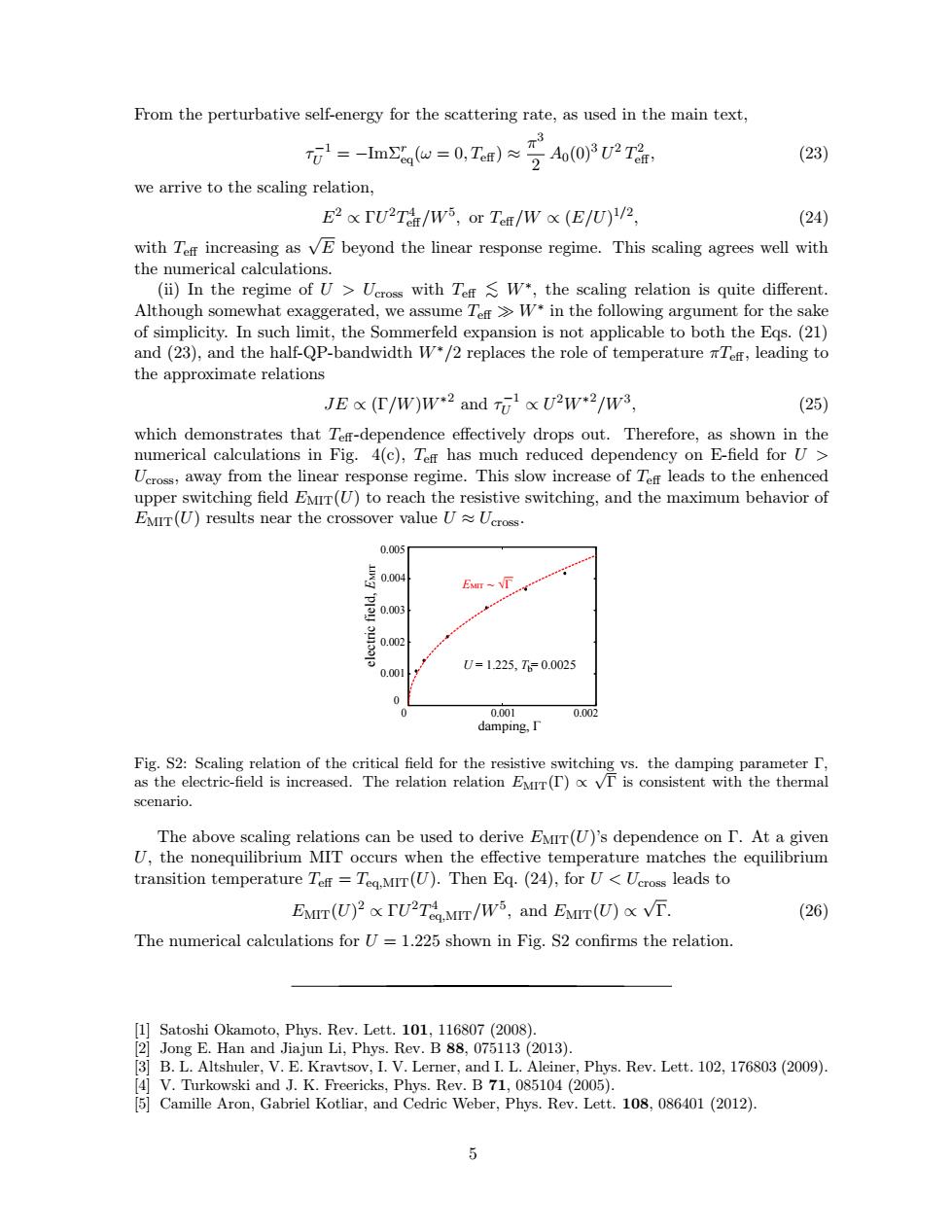正在加载图片...

From the perturbative self-energy for the scattering rate.as used in the main text. =-1mu=0,Tm)≈交An(03U2Ta (23) we arrive to the scaling relation, E2TU2T/W5,or Ten/W(E/U)2 (24) with To increasing as vE beyond the linear response regime.This scaling agrees well with the numerical calculations. (ii)In the regime of U>Ueroes with Tet W,the scaling relation is quite different Although somewhat exaggerated,we assume TW in the following argument for the sake of simplicity.In such limit,the Sommerfeld expansion is not applicable to both the Eqs.(21) and (23),and the half-QP-bandwidth W*/2 replaces the role of temperature Tef,leading to the approximate relations JE (r/W)w*2 and U2w+2/W3, (25) which de ennence tive switching,and the maximum behavior of 0.005 U-1225,160.002 0.00 Fig.S2:Scaling relation of the critical field for the resistive switching vs.the damping parameter I as the electric-field is increased.The relation relation Err(T)is consistent with the thermal scenario. The above scaling relations can be used to derive EMrr(U)'s dependence on I.At a given U,the nonequilibrium MIT occurs when the effective temperature matches the equilibrium transition temperature Tefr=TgMIT(U).Then Eq.(24),for U<s leads to ErU)/W5,and Er(U)T. (26) The numerical calculations for U=1.225 shown in Fig.S2 confirms the relation. moto, 3 B.L.Altshuler,V.E.Kravtsov,I.V.Lerner,and I.L.Aleiner,Phys.Rev.Lett.102.176803(2009). eber,Phs.Rev.Lett.108,086401(2012). 5From the perturbative self-energy for the scattering rate, as used in the main text, τ −1 U = −ImΣr eq(ω = 0, Teff) ≈ π 3 2 A0(0)3 U 2 T 2 eff, (23) we arrive to the scaling relation, E 2 ∝ ΓU 2T 4 eff/W5 , or Teff/W ∝ (E/U) 1/2 , (24) with Teff increasing as √ E beyond the linear response regime. This scaling agrees well with the numerical calculations. (ii) In the regime of U > Ucross with Teff <∼ W∗ , the scaling relation is quite different. Although somewhat exaggerated, we assume Teff
W∗ in the following argument for the sake of simplicity. In such limit, the Sommerfeld expansion is not applicable to both the Eqs. (21) and (23), and the half-QP-bandwidth W∗/2 replaces the role of temperature πTeff, leading to the approximate relations JE ∝ (Γ/W)W∗2 and τ −1 U ∝ U 2W∗2 /W3 , (25) which demonstrates that Teff-dependence effectively drops out. Therefore, as shown in the numerical calculations in Fig. 4(c), Teff has much reduced dependency on E-field for U > Ucross, away from the linear response regime. This slow increase of Teff leads to the enhenced upper switching field EMIT(U) to reach the resistive switching, and the maximum behavior of EMIT(U) results near the crossover value U ≈ Ucross. 0.005 0 damping, Γ 0.004 0.003 0.002 0.001 0 0.001 0.002 MIT electric field, E U = 1.225, Tb = 0.0025 EMIT ~ √Γ Fig. S2: Scaling relation of the critical field for the resistive switching vs. the damping parameter Γ, as the electric-field is increased. The relation relation EMIT(Γ) ∝ √ Γ is consistent with the thermal scenario. The above scaling relations can be used to derive EMIT(U)’s dependence on Γ. At a given U, the nonequilibrium MIT occurs when the effective temperature matches the equilibrium transition temperature Teff = Teq,MIT(U). Then Eq. (24), for U < Ucross leads to EMIT(U) 2 ∝ ΓU 2T 4 eq,MIT/W5 , and EMIT(U) ∝ √ Γ. (26) The numerical calculations for U = 1.225 shown in Fig. S2 confirms the relation. [1] Satoshi Okamoto, Phys. Rev. Lett. 101, 116807 (2008). [2] Jong E. Han and Jiajun Li, Phys. Rev. B 88, 075113 (2013). [3] B. L. Altshuler, V. E. Kravtsov, I. V. Lerner, and I. L. Aleiner, Phys. Rev. Lett. 102, 176803 (2009). [4] V. Turkowski and J. K. Freericks, Phys. Rev. B 71, 085104 (2005). [5] Camille Aron, Gabriel Kotliar, and Cedric Weber, Phys. Rev. Lett. 108, 086401 (2012). 5